Back to Journals » Open Access Journal of Sports Medicine » Volume 11
Injury Profile and Sex-Specific Differences in Bubble-Soccer – A First Scientific Survey of a Dangerous New Sports Trend
Authors Krutsch V, Clement A, Heising T, Achenbach L , Pfeifer C, Weber J, Alt V, Krutsch W
Received 2 July 2020
Accepted for publication 15 October 2020
Published 26 November 2020 Volume 2020:11 Pages 161—168
DOI https://doi.org/10.2147/OAJSM.S270363
Checked for plagiarism Yes
Review by Single anonymous peer review
Peer reviewer comments 3
Editor who approved publication: Prof. Dr. Andreas Imhoff
Volker Krutsch,1 Annabelle Clement,2 Tobias Heising,3 Leonard Achenbach,4 Christian Pfeifer,2 Johannes Weber,2 Volker Alt,2 Werner Krutsch2,5
1Department of Otorhinolaryngology, Paracelsus Medical University Nuremberg, Nuremberg, Germany; 2Department of Trauma Surgery, University Medical Centre Regensburg, Regensburg, Germany; 3Department of Internal Medicine, Marienhospital Osnabrueck, Osnabrueck, Germany; 4Department of Trauma Surgery, University Hospital Wuerzburg, Wuerzburg, Germany; 5SportDocsFranken, Nuremberg, Germany
Correspondence: Werner Krutsch
Department of Trauma Surgery, University Medical Centre Regensburg, Franz-Josef-Strauß Allee 1, Regensburg 93053, Germany
Tel +49 176 24225995
Email [email protected]
Purpose: Small-field soccer is a popular type of amateur sports worldwide. One type of small-field soccer growing in popularity is bubble-soccer, but injury risks and injury patterns are still unclear. This study investigates the factors influencing injuries in bubble-soccer for the first time.
Materials and Methods: This prospective cohort study of an outdoor tournament investigated the injury incidence and injury patterns as well as the factors influencing injuries in bubble-soccer matches. Data were collected according to the statement on data collection and injury definition. Preparation and physical outcome were assessed for both sexes.
Results: Of 145 players (104 men, 41 women), 58 players sustained 94 injuries during the tournament and 64% of injuries affected the lower extremities. The most common traumatic injuries were skin lesions (37.5%), acute pain (15.6%) and contusion (7.8%). More female players (3818.2/1000 h bubble-soccer) than male players (1474.4) were affected by injury, mostly to the knees or the head. Also, women significantly more often reported neck pain than men (p< 0.042); 29.0% of players felt uncomfortable wearing the bubble, and 21.4% reported neurological symptoms such as headache or dizziness after the match.
Conclusion: Bubble-soccer shows a relatively high injury incidence. Women had a higher injury incidence and were more often affected by traumatic injuries to the head and neck including feeling of discomfort and headache or neck pain after the match. Adequate preparation seems to be essential for injury prevention, and players should recognise the high injury risk of bubble-soccer.
Keywords: bubble soccer, injury, soccer, risk factor, prevention
Introduction
Soccer is the most popular type of sports with more than 300 million players registered in soccer clubs worldwide.1,2 The majority of soccer players play at the recreational level, and amateur tournaments represent a typical match mode.3,4 As a result of the popularity of soccer, more and more soccer variations are being invented. These soccer variations often constitute adaptations to specific environments. Examples are beach soccer played on sandy beaches and in warmer regions and futsal, a type of indoor soccer with specific regulations, which is played in halls or gyms. Blind soccer is adapted to the needs of blind players and walking soccer to the requirements of elderly players.5–8 Another new type of soccer is bubble-soccer, which is played on a small-field soccer pitch. As an outdoor event, bubble-soccer is played on grass and, as an indoor event, on artificial turf. This sports trend has its own regulations, and players have to wear a huge air-inflated balloon over their torso and head for protection.9 The unique combination of traditional small-field soccer and the use of extraordinary protection wear allows players to bump into each other, so that the resulting collisions and falls cause little or no injury. However, it is not yet clear whether the protection wear and current regulations are suitable for preventing injuries.
Epidemiological injury data are sufficient in national and international professional soccer10–12 but rare in registered recreational soccer, although some data are available.2,3 Scientific injury data on small-field amateur soccer tournaments have been published recently,4 and first scientific reports are now available on the injury patterns of other soccer trends such as beach soccer and futsal.13–15 However, no scientific injury data on bubble-soccer are yet available in the literature. The question is whether the injury patterns of this type of soccer-related sports are comparable to those of traditional small-field soccer. The hypothesis of this study was that bubble-soccer has its own specific injury profile.
Materials and Methods
Study Population
The investigated national annual bubble-soccer tournament, which took place during the student festival ‘Medimeisterschaften’ in 2018–2019, was analysed in a prospective cohort study. The players of 51 teams were analysed regarding injuries, perception and well-being during the bubble-soccer matches. Men and women played in mixed teams. All players who participated in at least one match of the tournament were included in the injury investigation. Exclusion criteria were missing or incomplete injury reports and players injured before the tournament.
Tournament Rules
As outdoor events, small-field bubble-soccer tournaments are played on natural grass. According to the 1-day tournament mode, each team plays 6 matches in the first round, and the best two teams of each group play in the knockout phase. One match takes 8 minutes. Match rules of bubble-soccer tournaments are basically aligned to the international rules of football of the World Football Association FIFA (www.fifa.com). Several rules have been adapted to the specific conditions applying to bubble-soccer:
- Only registered students are allowed to play in the tournament. Participants need to present an identity card and an official student ID-card issued by their university.
- The mixed teams are formed by male and female players.
- A minimum of 4 players per team is required.
- The starting teams consist of 4 players each, meaning 4 outfield players per team without a goalkeeper.
- The field measures 30 metres by 20 metres with two goals measuring 5 metres by 2 metres (small field).
- Every player is required to wear a bumper or bubble.
- There is no hand foul, and goals are allowed to be scored with the bumper and every part of the body.
- The number of substitutions of players during the match is not restricted.
- There is no offside rule.
- Matches last 8 minutes.
- Bumping is only allowed from the front and the side. Bumping from behind is restricted and rated as foul play.
- Only indirect free kicks are awarded to the teams, for which the opponents have to leave a distance of at least 2 metres.
- Penalty kicks are played from the 9-metre spot.
- Players committing a foul or unfair play may be sent off for 2 minutes.
- More severe fouls and insults to the referee or other players may be punished with a 2-minute penalty for the offending team plus exclusion of the offending player from the tournament.
- The first round consists of 6 groups with 5 to 6 teams each.
- The knockout phase includes the last 12 teams.
The principle aim of this new sports trend is playing soccer with a high fun factor. Wearing the bubble while playing allows the players to bump into each other while their bodies are protected as much as possible. The official sportive aim of this trend sports is scoring goals, but a secondary aim is the fun of colliding, falling and rolling in the bubble on the floor (Figure 1).9
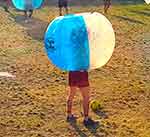 |
Figure 1 Player wearing a bubble. |
Data Collection
Data collection started with a standardised self-administered questionnaire developed by this study group. The questionnaire was based on previous epidemiological studies on amateur soccer by this study group,3,4,16,17 the consensus statement established by Fuller et al (2006) and the UEFA model for injury analysis in soccer.18,19 Four weeks before the bubble-soccer tournament, all participating players were informed about the epidemiological injury investigation of the entire tournament. At the beginning of the tournament, all team captains were briefed on the study guidelines by email and in an instructional course in the morning of the match day. Additionally, each player received the study design and the questionnaire with informative consent in print. The questionnaire requested personal and anthropometric data, specific bubble-soccer data, injury patterns and factors influencing injuries. Of particular interest was information on match preparation, well-being and perception.
After the last match of the day, all completed questionnaires were collected. The incidence of injuries was assessed by means of the questionnaire, with special emphasis on traumatic and overuse injuries as defined in the literature.18 Additionally, the affected body sites were analysed as well as the type of injury and the individual match exposure during the tournament (in minutes played). The injury incidence was calculated as the number of injuries per 1000 h match exposure. Exact data on the training exposure of each player before the tournament were lacking. Sustained injuries were diagnosed, if necessary, by the medical staff of the tournament provided by the ‘Deutsche Rote Kreuz’ (German Red Cross). The study design was approved by the Ethics Committee of the University of Regensburg (No. 11–167-1-101).
Statistical Analysis
Continuous data are presented as mean ± standard deviation (SD) and categorical data as frequency counts (percentages). Proportions between two groups were compared with the Fisher’s exact test and continuous variables with the t-test. Incidence rates were compared with an exact test based on the Poisson distribution. The level of significance was set to p<0.05 and high significance to p<0.01. All analyses were done using IBM SPSS Statistics, version 22.0 and R (version 3.0.3).
Results
Of the complete study population of 255 players, 145 players (56.9%) were included in the first injury analysis of bubble-soccer. One hundred and ten players were excluded because of incomplete or missing injury data, resulting in a drop-out rate of 43.1%. No differences in mean age were found between men and women (Table 1). Male players had significant (p<0.0001) more playing time than female players.
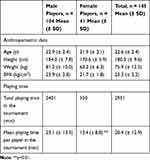 |
Table 1 Anthropometric and Specific Bubble-Soccer Data |
Male players had significantly (p<0.0001) more often participated in regular soccer training before the tournament than female players. Most study participants had no experience in playing bubble-soccer (66.9%), but male players had significantly more experience (p=0.003) in playing bubble-soccer than female players (Table 2).
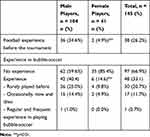 |
Table 2 Details on Bubble-Soccer |
Overall, 94 injuries occurred in 58 players (40.0%). The overall incidence in 1000 hours of bubble-soccer was 1474.4 in male players and 3818.2 in female players. 68.1% of all injuries were traumatic injuries without any statistically significant difference between men and women. 31.9% of all injuries were overuse injuries, and here the percentage of women was significantly higher than that of men (p <0.048). Six players sustained both overuse and traumatic injuries (Table 3).
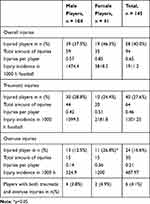 |
Table 3 Injury Incidence and Injury Pattern in Bubble-Soccer |
The most frequent traumatic injuries were skin lesions (37.5%), acute pain (15.6%) and contusion (7.8%). Concussion was diagnosed in two patients (5%). The body sites most frequently affected by traumatic injury were the knees (25%), the head (15.6%) and the feet and ankles (15.6%). Female players sustained significantly (p<0.042) more often traumatic injuries to the neck than male players. The body sites most affected by overuse injuries were the head (26.7%), the knees (23.3%) and the neck (16.7%) without any significant differences between men and women (Table 4).
 |
Table 4 Type and Body Site of Injuries in Bubble-Soccer |
Eighty percent of all injuries were caused by contact with other players on the field. The most common injury mechanisms were movements specific for bubble-soccer such as collision of the bubbles (47.0%) and falls to the ground (45.0%). Injuries were caused by both attack and defence movements (Figure 2).
 |
Figure 2 (A–C) Injury patterns in bubble-soccer. |
Of all players, 90.3% felt protected by the bubble, whereas 29% felt uncomfortable wearing the bubble, mainly due to bad air (35.7%), collisions (23.8%), feeling of tightness (14.3%) and heat (11.9%). 21.4% of the players reported neurological symptoms during the match and afterwards. Female players tended to have more neurological symptoms than male players, but the result was not statistically significant. The most common neurological symptoms were headache (13.8%), dizziness (8.3%) and neck pain (9.0%). However, female players experienced significantly more often (p<0.009) neck pain than male players (Table 5).
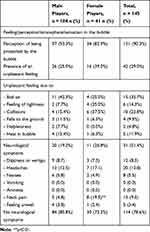 |
Table 5 Perception During and After the Bubble-Soccer Tournament |
Discussion
The first scientific investigation of bubble-soccer shows that this trend sports is a dangerous type of sports with a high injury incidence. The injury incidence with overall 1911 injuries in 1000 hours sports exposure indicates that bubble-soccer has a higher injury risk than regular soccer at amateur or elite levels.2,3,10,17 Bubble-soccer has an even higher injury risk than other types of soccer such as futsal or beach soccer.13–15 Also, surveys of traditional small-field soccer tournaments have shown that the injury incidence of regular soccer on small fields is much lower than that of bubble-soccer.4 This study showed that most injuries sustained in bubble-soccer affect the lower extremities, the head and the neck. Injury distribution is similar to that in amateur and professional soccer, thus indicating a similar need for injury prevention strategies.20,21 Beside traumatic injuries, this study also investigated overuse pain and complaints during and after the bubble-soccer tournament. For the first time, this study showed a high percentage of players with head and neck pain as well as knee pain.
In traditional soccer, female players have a higher injury incidence than male players, especially with regard to some types of injury.22,23 Because this tournament was played by mixed teams, this study provides a unique view on sex-specific differences in bubble-soccer. As a potential result of gender-mixed teams, women sustained both more overuse injuries and more traumatic injuries to the head, neck and lower extremities, most likely because of their higher physical vulnerability of these body sites.24,25 One further potential consequence of less developed neck muscles in women is the higher risk of neurological symptoms and concussion in bubble-soccer and other sports.26 Thus, the higher injury incidence of women in this tournament may be due to the participation of mixed teams, in which male players with a higher body weight bump into shorter female players with a lower body weight. Therefore, one important strategy to decrease the injury rate of women in bubble-soccer is the avoidance of mixed teams.
This study showed that players feel safe in the bubble during the game; however, a majority of players complained about discomfort and neurological symptoms during the game. Therefore, it should be investigated whether the bubble covering the player’s torso and head really offers the expected protection. The bubble reduces the impact of the bump against other players or with the ground. However, this impact also leads to unexpected movements of the bubble, which often result in falling to the ground and subsequent rolling on the ground. Additionally, this study showed the lower extremities to be the body site most affected by both traumatic and overuse injuries. The reason behind this finding is that the lower extremities are hardly protected in bubble-soccer. In soccer and other types of ball sports, prevention of knee and ankle injuries starts with adequate preparation and warm-up programmes before sports activity.3,4,27,28 Before the investigated bubble-soccer tournament, hardly any adequate preparation or warm-up programme was carried out, which may be the main reason for the high number of injuries to the lower extremities. Also, the fact that bubble-soccer was a new experience for the majority of players leads to the conclusion that unexpected movements and falls may influence the occurrence of injuries. In the knowledge that bubble-soccer is not a frequently played type of sports but a sports trend played at certain events, it is questionable how players may improve their experience or skills and consequently their behaviour and prevention performance.
For the practical routine of future bubble-soccer matches, it is essential to improve match regulations, protection wear, players’ behaviour and physical preparation.29 In well-organised types of sports such as soccer and handball, staff members and organisation teams help improve injury prevention. Also, injury prevention is furthered by soccer associations adapting match regulations or by team coaches implementing structured training and warm-up programmes. In general, investigations into the injury profile of men and women are essential for assessing the success of implementing warm-up programmes to improve injury prevention on field.28,30 Sports trends at events or festivals as usually seen in bubble-soccer show the limitations of such injury prevention strategies.
This study has some limitations that should be considered when interpreting the data. This study has a relatively small sample size but represents the first and only existing study on the injury risks of this popular sports trend. Additionally, this study has a relatively high dropout rate; however, the rate is comparable to that of other previously published injury surveys in amateur sports. The setting and structure of amateur sports events sometimes weakens the methodology of a study. Nevertheless, this study provides unique data on a popular sports trend tournament in Europe with a structured data sample based on scientific guidelines. The medical service provided during the tournament may also represent a weakness of this study because diagnoses were only based on the assessment by medical staff during the tournament. Besides the medical assessment on field, this study provides no further diagnostic or therapeutic value or outcome. But this first scientific study represents the basis for future studies to implement reliable rules for bubble-soccer including standardised prevention and warm-up programmes comparable to those in other amateur ball sports.3,4,27
Conclusion
Bubble-soccer is a new sports trend with a high injury incidence. Women had a higher injury incidence, more traumatic injuries to head and neck and experienced more discomfort including headache or neck pain after the match. Adequate preparation before playing bubble-soccer seems to be essential for injury prevention, and players should recognise the high injury risk of this sports trend. In addition to physical preparation, match regulations with clear restrictions are required as well as changes in players’ behaviour or improvement in protection equipment.
Disclosure
The authors report no conflict of interest in this work.
References
1. Dvorak J, Graf-Baumann T, Peterson L, Junge A. Football, or soccer, as it is called in North America, is the most popular sport worldwide. Am J Sports Med. 2000;28(5_suppl):S1–2. doi:10.1177/28.suppl_5.s-1
2. Herrero H, Salinero JJ, Del Coso J. Injuries among Spanish male amateur soccer players: a retrospective population study. Am J Sports Med. 2014;42(1):78–85. doi:10.1177/0363546513507767
3. Koch M, Zellner J, Berner A, et al. Influence of preparation and football skill level on injury incidence during an amateur football tournament. Arch Orthop Trauma Surg. 2016;136(3):353–360. doi:10.1007/s00402-015-2350-3
4. Krutsch V, Clement A, Heising T, et al. Influence of poor preparation and sleep deficit on injury incidence in amateur small field football of both gender. Arch Orthop Trauma Surg. 2020;140(4):457–464. doi:10.1007/s00402-019-03261-0
5. Federation Internationale de Football Association. Beach Soccer-Laws of the Game 2015/2016. Zurich, Switzerland: Federation Internationale de Football Association; 2015.
6. Federation Internationale de Football Association. Futsal- Laws of the Game 2014/2015. Zurich, Switzerland: Federation Internationale de Football Association; 2014.
7. Football Five A-Side Laws 2017–2021. [www.ibsasport.org]. International Blind Sports Federation; 2017. Available from: https://www.ibsasport.org/news/files/1055-2-IBSA-Blind-Football-(B1)-Rulebook-2017–2021.pdf.
8. Walking Football Laws of the Game 2019. [www.walkingootball.com]. Walking Football Association; 2019. Available from: https://www.walkingfootball.com/features/articles/the-fa-walking-football-association-rules-r142/.
9. The official Bubble Football World Cup. [www.thestagcompany.com]. The Stag Company; 2017. Available from: https://www.thestagcompany.com/bubble-football-world-cup.
10. Ekstrand J, Hagglund M, Walden M. Injury incidence and injury patterns in professional football: the UEFA injury study. Br J Sports Med. 2011;45(7):553–558. doi:10.1136/bjsm.2009.060582
11. Hagglund M, Walden M, Ekstrand J. UEFA injury study – an injury audit of European Championships 2006 to 2008. Br J Sports Med. 2009;43(7):483–489. doi:10.1136/bjsm.2008.056937
12. Walden M, Hagglund M, Ekstrand J. Football injuries during European Championships 2004–2005. Knee Surg Sports Traumatol Arthrosc. 2007;15(9):1155–1162. doi:10.1007/s00167-007-0290-3
13. Shimakawa T, Shimakawa Y, Kawasoe Y, et al. Beach soccer injuries during the Japanese national championships. Orthop J Sports Med. 2016;4(1):2325967115625636. doi:10.1177/2325967115625636
14. Ahmad-Shushami AH, Abdul-Karim S. Incidence of football and futsal injuries among youth in Malaysian games 2018. Malays Orthop J. 2020;14(1):28–33. doi:10.5704/MOJ.2003.005
15. Lopes M, Simões D, Costa R, Oliveira J, Ribeiro F. Effects of the FIFA 11+ on injury prevention in amateur futsal players. Scand J Med Sci Sports. 2020;30(8):1434–1441. doi:10.1111/sms.13677
16. Krutsch W, Weishaupt P, Zeman F, et al. Sport-specific trunk muscle profiles in soccer players of different skill levels. Arch Orthop Trauma Surg. 2015;135(5):659–665. doi:10.1007/s00402-015-2178-x
17. Krutsch W, Zeman F, Zellner J, Pfeifer C, Nerlich M, Angele P. Increase in ACL and PCL injuries after implementation of a new professional football league. Knee Surg Sports Traumatol Arthrosc. 2016;24(7):2271–2279. doi:10.1007/s00167-014-3357-y
18. Fuller CW, Ekstrand J, Junge A, et al. Consensus statement on injury definitions and data collection procedures in studies of football (soccer) injuries. Br J Sports Med. 2006;40(3):193–201. doi:10.1136/bjsm.2005.025270
19. Hagglund M, Walden M, Bahr R, Ekstrand J. Methods for epidemiological study of injuries to professional football players: developing the UEFA model. Br J Sports Med. 2005;39(6):340–346. doi:10.1136/bjsm.2005.018267
20. Krutsch W, Lehmann J, Jansen P, et al. Prevention of severe knee injuries in men`s elite football by implementing specific training modules. Knee Surg Sports Traumatol Arthrosc. 2020;28(2):519–527. doi:10.1007/s00167-019-05706-w
21. Loose O, Fellner B, Lehmann J, et al. Injury incidence in semi-professional football claims for increased need of injury prevention in elite junior football. Knee Surg Sports Traumatol Arthrosc. 2019;27(3):978–984. doi:10.1007/s00167-018-5119-8
22. Clausen MB, Zebis MK, Møller M. High injury incidence in adolescent female soccer. Am J Sports Med. 2014;42(10):2487–2494. doi:10.1177/0363546514541224
23. Walden M, Hägglund M, Werner J, Ekstrand J. The epidemiology of anterior cruciate ligament injury in football (soccer): a review of the literature from a gender-related perspective. Knee Surg Sports Traumatol Arthrosc. 2011;19(1):3–10. doi:10.1007/s00167-010-1172-7
24. Abe T, Kearns C, Fukunaga T. Sex differences in whole body skeletal muscle mass measured by magnetic resonance imaging and its distribution in young Japanese adults. Br J Sports Med. 2003;37(5):436–440. doi:10.1136/bjsm.37.5.436
25. Perez-Gomez J, Rodriguez GV, Ara I, et al. Role of muscle mass on sprint performance: gender differences? Eur J Appl Physiol. 2008;102(6):685–694. doi:10.1007/s00421-007-0648-8
26. Mortensen JD, Vasavada AN, Merryweather AS. Sensitivity analysis of muscle properties and impact parameters on head injury risk in American football. J Biomech. 2020;100:109411. doi:10.1016/j.jbiomech.2019.109411
27. Achenbach L, Krutsch V, Weber J, et al. Neuromuscular exercises prevent severe knee injury in adolescent team handball players. Knee Surg Sports Traumatol Arthrosc. 2018;26(7):1901–1908. doi:10.1007/s00167-017-4758-5
28. Barengo NC, Meneses-Echavez JF, Ramirez-Velez R, Cohen DD, Tovar G, Bautista JE. The impact of the FIFA 11+ training program on injury prevention in football players: a systematic review. Int J Environ Res Public Health. 2014;11(11):11986–12000. doi:10.3390/ijerph111111986
29. Klügl M, Shrier I, McBAin K, et al. The prevention of sport injury: an analysis of 12,000 published manuscripts. Clin J Sport Med. 2010;20(6):407–412. doi:10.1097/JSM.0b013e3181f4a99c
30. Soligard T, Myklebust G, Steffen K, et al. Comprehensive warm-up programme to prevent injuries in young female footballers: cluster randomised controlled trial. BMJ. 2008;337(dec09 2):a2469. doi:10.1136/bmj.a2469
 © 2020 The Author(s). This work is published and licensed by Dove Medical Press Limited. The full terms of this license are available at https://www.dovepress.com/terms.php and incorporate the Creative Commons Attribution - Non Commercial (unported, v3.0) License.
By accessing the work you hereby accept the Terms. Non-commercial uses of the work are permitted without any further permission from Dove Medical Press Limited, provided the work is properly attributed. For permission for commercial use of this work, please see paragraphs 4.2 and 5 of our Terms.
© 2020 The Author(s). This work is published and licensed by Dove Medical Press Limited. The full terms of this license are available at https://www.dovepress.com/terms.php and incorporate the Creative Commons Attribution - Non Commercial (unported, v3.0) License.
By accessing the work you hereby accept the Terms. Non-commercial uses of the work are permitted without any further permission from Dove Medical Press Limited, provided the work is properly attributed. For permission for commercial use of this work, please see paragraphs 4.2 and 5 of our Terms.
